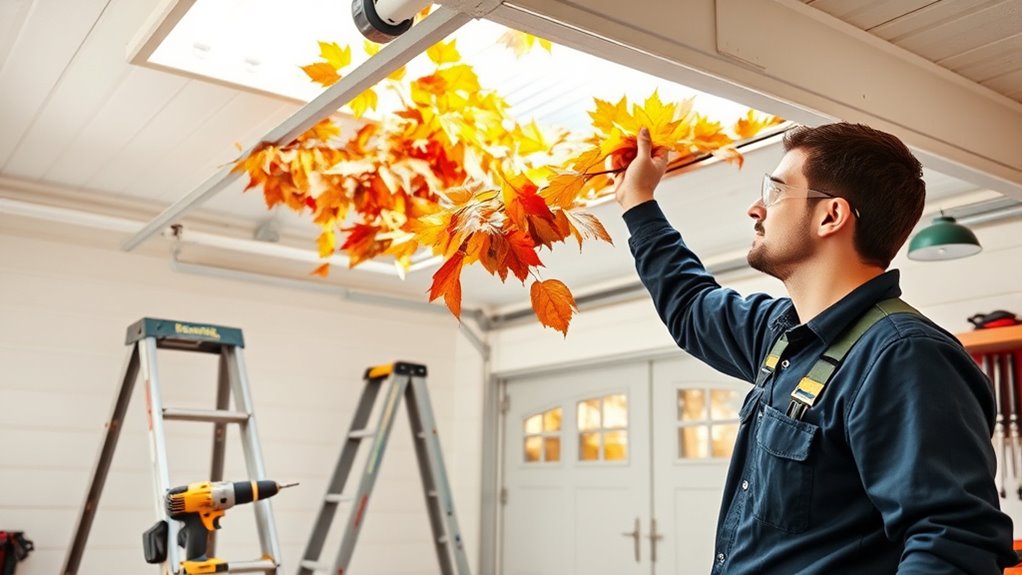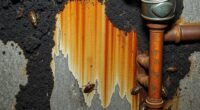Professionals handle seasonal home maintenance tasks like inspecting and tuning up your HVAC system, checking your roof and gutters for damage or blockages, and sealing any leaks around windows and doors. They also perform thorough plumbing checks, flush systems to prevent buildup, and give exterior surfaces a fresh coat of paint while weatherproofing. These tasks can prevent costly repairs and keep your home safe. Keep going to discover what else pros do to keep your home in top shape.
Key Takeaways
- Professionals conduct thorough HVAC inspections, including refrigerant checks and coil cleaning, beyond basic filter replacements.
- Pros perform detailed roof and gutter assessments, identifying issues like missing shingles or damaged flashing to prevent leaks.
- Experts carry out comprehensive plumbing inspections, detecting leaks and performing preventative flushing to avoid costly repairs.
- Seasonal pros ensure ventilation systems and appliances are properly maintained and inspected for safety and efficiency.
- They implement overall safety measures, including weatherproofing, sealing heat leaks, and maintaining structural integrity to prevent hazards.
Pre-Season HVAC System Inspections and Tune-Ups

Before the heating or cooling season begins, it’s crucial to schedule a pre-season HVAC system inspection and tune-up. This guarantees your system runs efficiently and prevents unexpected breakdowns. Start by replacing the air filter, which improves indoor air quality and allows your system to operate smoothly. Next, have a professional check the refrigerant level; low refrigerant can cause your AC to work harder and reduce cooling effectiveness. During the tune-up, technicians inspect all components, clean coils, and verify system pressures. Addressing these areas early helps catch potential issues before they escalate. Regular pre-season maintenance not only extends your HVAC system’s lifespan but also ensures comfort and energy efficiency throughout the season. Incorporating system calibration can further optimize your system’s performance and ensure accurate temperature control. Don’t skip this essential step for a hassle-free heating or cooling experience.
Gutter and Roof Assessments for Damage and Blockages
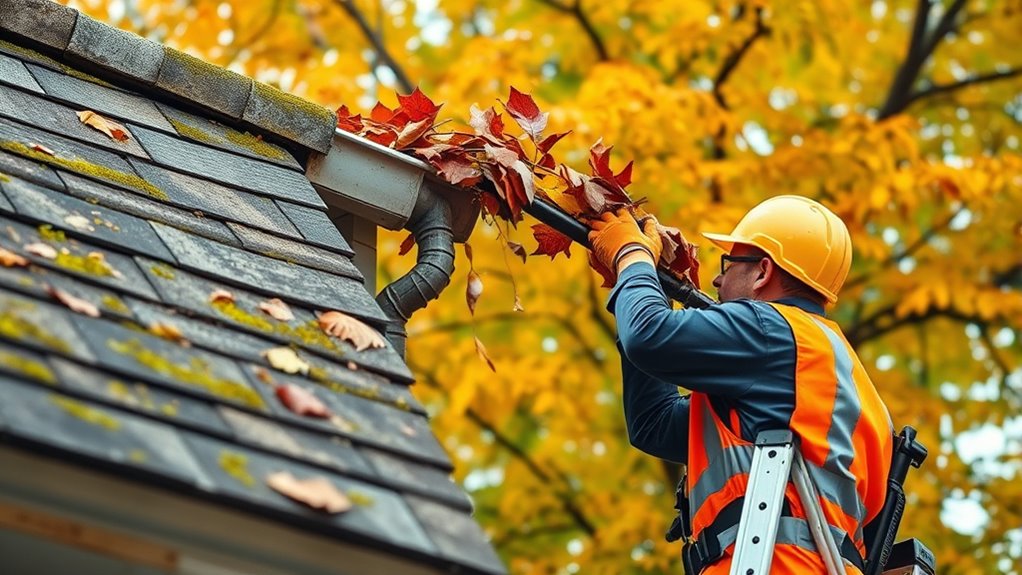
After completing your HVAC inspections, it’s time to examine your gutters and roof for any damage or blockages that could cause issues during heavy rains or snowmelt. Clear out gutter debris to prevent clogs that can cause water backup and potential foundation problems. Look for signs of roof damage, such as missing shingles, curling edges, or cracked flashing, which can lead to leaks. Check for sagging gutters or areas where debris has accumulated, indicating blockages that need clearing. Inspect the roof surface for loose or damaged tiles or shingles, and ensure flashing around chimneys and vents is intact. Addressing these issues early helps prevent costly repairs later and keeps your home protected from water intrusion during severe weather. Regular gutter maintenance is essential for maintaining proper drainage and prolonging the life of your roof.
Seasonal Sealing and Insulation Checks
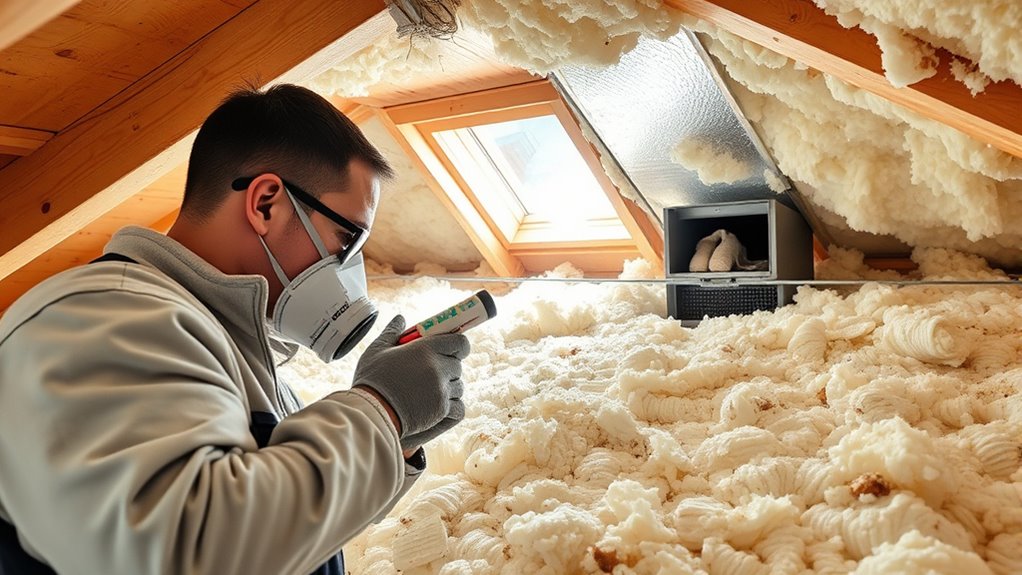
As temperatures fluctuate with the seasons, it’s essential to check your home’s sealing and insulation to maintain energy efficiency and comfort. Use thermal imaging to identify hidden heat leaks around windows, doors, and walls. Proper air sealing minimizes drafts and reduces heating and cooling costs. Inspect your insulation levels in attic and wall spaces, adding more if needed. Sealing gaps prevents moisture buildup and improves indoor air quality. Here’s a quick overview:
| Step | What to Do | Why it Matters |
|---|---|---|
| Thermal Imaging Scan | Detect hidden leaks | Find areas needing sealing |
| Air Sealing | Seal gaps around windows, doors, vents | Prevent drafts and energy loss |
| Insulation Inspection | Check existing insulation, add if necessary | Boosts energy efficiency |
Additionally, verifying that your headphones are functioning correctly can enhance your home entertainment setup during the colder months, ensuring clear audio whether watching movies or listening to music.
Exterior Painting and Weatherproofing Strategies
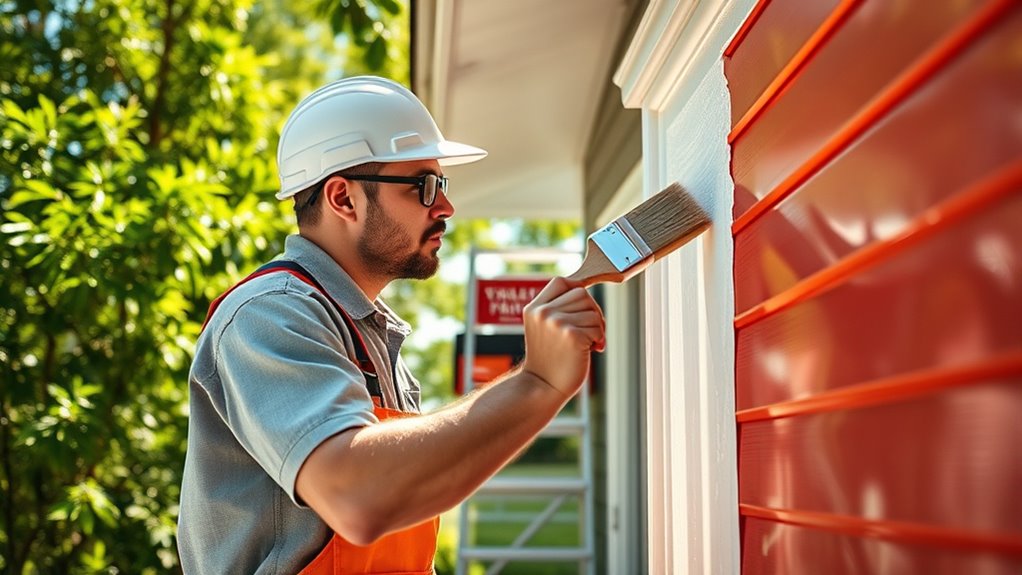
Maintaining your home’s exterior through painting and weatherproofing is vital for protecting it against the elements and extending its lifespan. When you choose the right paint, color matching ensures a seamless look that enhances your home’s curb appeal. Proper weatherproofing involves applying high-quality sealants and coatings to prevent water infiltration and damage. Keep in mind that patience during paint drying is essential; rushing this step can compromise the finish and reduce durability. Inspect your exterior regularly, touch up chipped paint, and reapply weatherproofing treatments as needed. By staying attentive to these details, you’ll help your home resist weather-related wear and tear, saving you time and money in the long run. Proper exterior maintenance maintains beauty and structural integrity.
Plumbing System Flushing and Leak Prevention
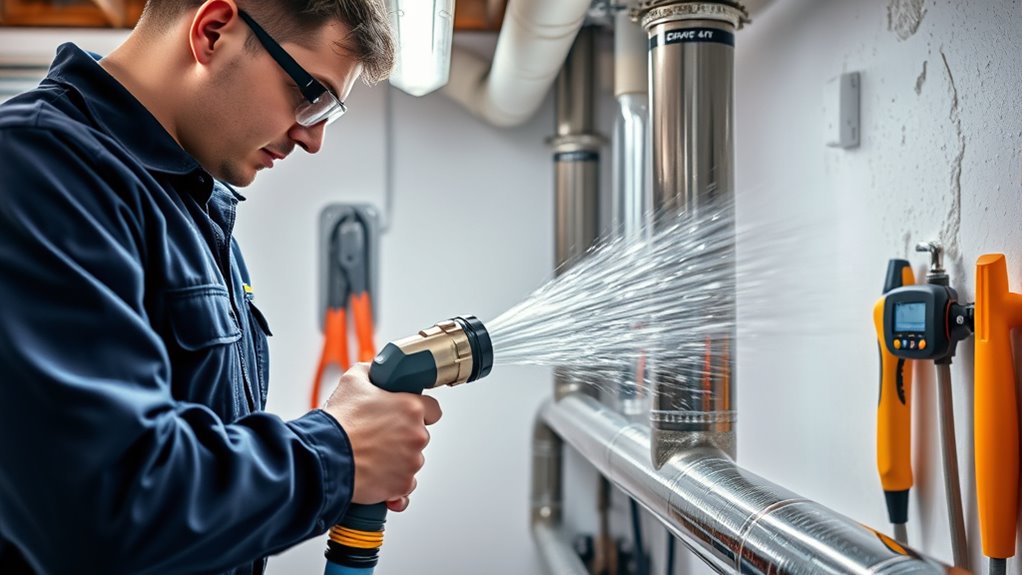
To keep your plumbing running smoothly, start by inspecting your drainage system for any blockages or signs of wear. Use leak detection techniques to identify hidden leaks before they cause damage, and perform preventative flushing to clear out mineral buildup. Taking these steps now can help prevent costly repairs and make certain your system stays leak-free all season long. Regular maintenance also involves checking for clogged drains and ensuring proper drainage flow to avoid backups and flooding.
Drainage System Inspection
Regularly inspecting your drainage system is essential for preventing costly repairs and ensuring smooth operation. A well-designed drainage system supports effective erosion control and minimizes water damage. To keep it in top shape, focus on these key steps:
- Check for clogs or blockages in drains and pipes, ensuring water flows freely.
- Examine the drainage design around your property, making sure slopes direct water away from your foundation.
- Look for signs of erosion or standing water that could indicate issues needing prompt attention.
- Incorporate proper maintenance routines to sustain the integrity of your drainage system over time.
Leak Detection Techniques
Detecting leaks early in your plumbing system can save you from costly repairs and water waste. Start by checking for signs like damp patches, mold, or musty odors, which can indicate hidden leaks. Foundation cracks may also result from water infiltration caused by undetected leaks, so keep an eye out for cracks widening over time. Monitoring indoor humidity levels helps too—excess moisture can suggest hidden leaks or plumbing issues. Use a moisture meter or hygrometer to track humidity; high levels may point to leaks behind walls or under floors. Regular visual inspections of exposed pipes and fixtures can catch leaks before they escalate. Additionally, understanding air quality and proper ventilation can help prevent mold growth caused by persistent moisture from leaks. By staying vigilant and addressing small issues promptly, you prevent larger problems and maintain a healthy, efficient plumbing system.
Preventative Flushing Procedures
Implementing preventative flushing procedures is a proactive way to keep your plumbing system in excellent condition and reduce the risk of leaks. Regular flushing improves water quality by removing sediment, rust, and debris that can cause pipe corrosion over time. To ensure your system stays in top shape:
- Flush out water heaters annually to prevent mineral buildup.
- Routinely clear faucet aerators and showerheads to maintain ideal flow.
- Use a professional service to perform thorough pipe flushing, removing sediment and buildup that compromise water quality.
These steps help identify early signs of corrosion, extend pipe lifespan, and minimize costly repairs. Preventative flushing keeps your plumbing running smoothly, safeguarding your home from leaks and maintaining water integrity.
Appliance and Ventilation System Maintenance
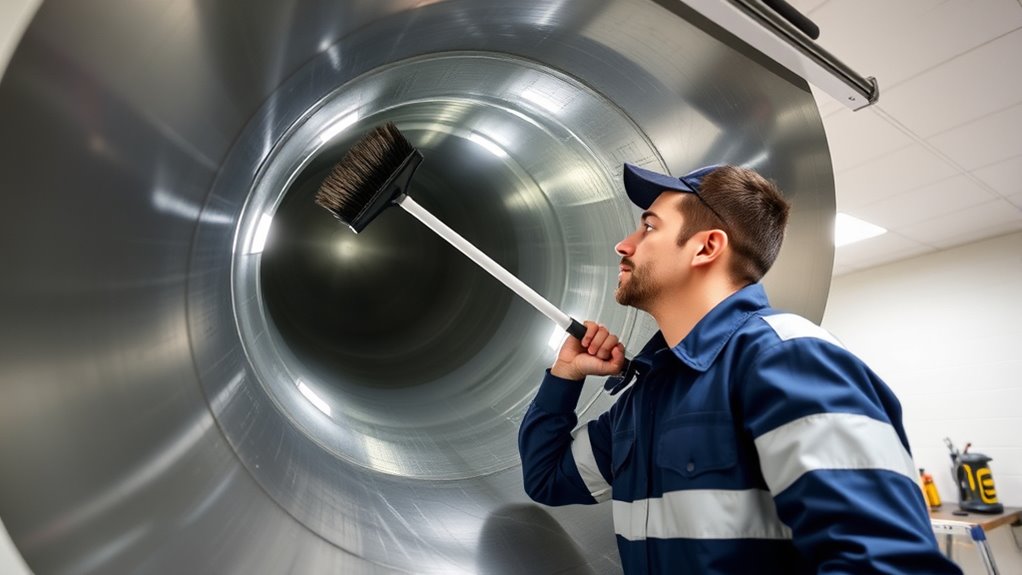
Maintaining your appliances and ventilation systems guarantees they operate efficiently and last longer. Regularly clean your vents and filters to improve ventilation efficiency and prevent dust buildup that can hinder airflow. Check your appliance connections for leaks or damage, ensuring safety and ideal performance. Replace filters in HVAC systems and kitchen exhausts every few months to maintain air quality and prevent malfunctions. Keep dryer vents clear of lint to reduce fire risks and improve dryer efficiency. Schedule professional inspections annually to catch issues early, ensuring your appliances are safe and functioning correctly. Proper upkeep not only extends their lifespan but also helps improve indoor air quality and creates a healthier, safer home environment. Staying proactive with appliance and ventilation maintenance is a simple step that saves money and stress in the long run.
Frequently Asked Questions
How Often Should I Schedule Seasonal Home Maintenance Visits?
You should schedule seasonal home maintenance visits at least twice a year, ideally in spring and fall. During these visits, a professional roof inspection helps catch damage early, while gutter cleaning prevents clogs and water damage. Regular maintenance keeps your home in top shape, reduces costly repairs, and guarantees safety. Don’t wait until issues worsen—stay proactive by scheduling these seasonal checks to protect your investment.
What Are Signs My Home Needs Urgent Seasonal Repairs?
Watch for signs like drafts, uneven heating, or rising energy bills, which indicate your home needs urgent repairs. Check your home insulation for gaps or compression, and inspect roof flashing for leaks or damage. If you notice water stains, mold, or increased pests, don’t delay calling a professional. These signs show your home’s systems are compromised and need immediate attention to prevent further damage.
Can DIY Home Maintenance Replace Professional Inspections?
You might think DIY home maintenance can replace professional inspections, but it’s risky. DIY pitfalls include missing hidden issues or using tools that aren’t as effective as professional equipment. Professionals have the expertise and access to specialized tools to identify problems you might overlook. Relying solely on DIY can lead to costly repairs later. It’s best to schedule regular inspections to make sure your home stays in top shape and safety is maintained.
Which Seasonal Tasks Are Crucial for Energy Efficiency?
You should prioritize seasonal tasks that boost energy efficiency, like insulation upgrades and weatherproofing tips. These help keep your home warm in winter and cool in summer, saving you money. Regularly check seals around doors and windows, add insulation where needed, and seal leaks with weatherstripping. By doing these tasks yourself, you maintain comfort and reduce energy bills, but don’t hesitate to call pros for complex insulation or extensive weatherproofing projects.
How Do Pros Identify Hidden Damage During Inspections?
Think of inspection techniques as your home’s secret detective, uncovering hidden damage lurking beneath the surface. Pros use specialized tools like moisture meters and infrared cameras to detect damage detection that’s invisible to the naked eye. They carefully scan walls, roofs, and foundations, listening for subtle clues. This keen eye and advanced equipment help pros spot issues early, saving you from costly surprises and ensuring your home stays strong and safe.
Conclusion
Did you know that regular seasonal home maintenance can save you up to 30% on energy costs? By tackling tasks like inspecting your HVAC, gutters, and plumbing, you keep your home running efficiently and avoid costly repairs. While pros handle the big jobs, staying proactive with these seasonal checks guarantees your home stays comfortable and damage-free year-round. Make maintenance a habit—you’ll enjoy peace of mind and extra savings in the long run.
